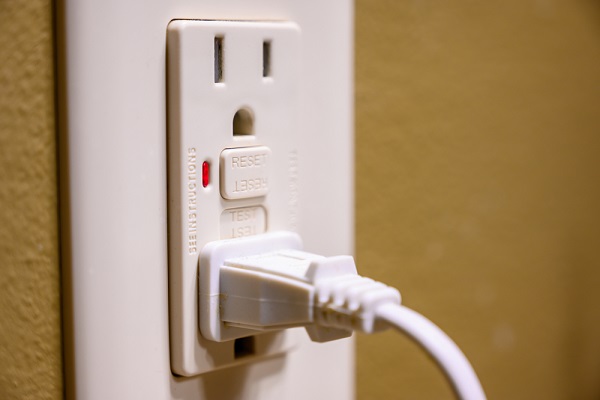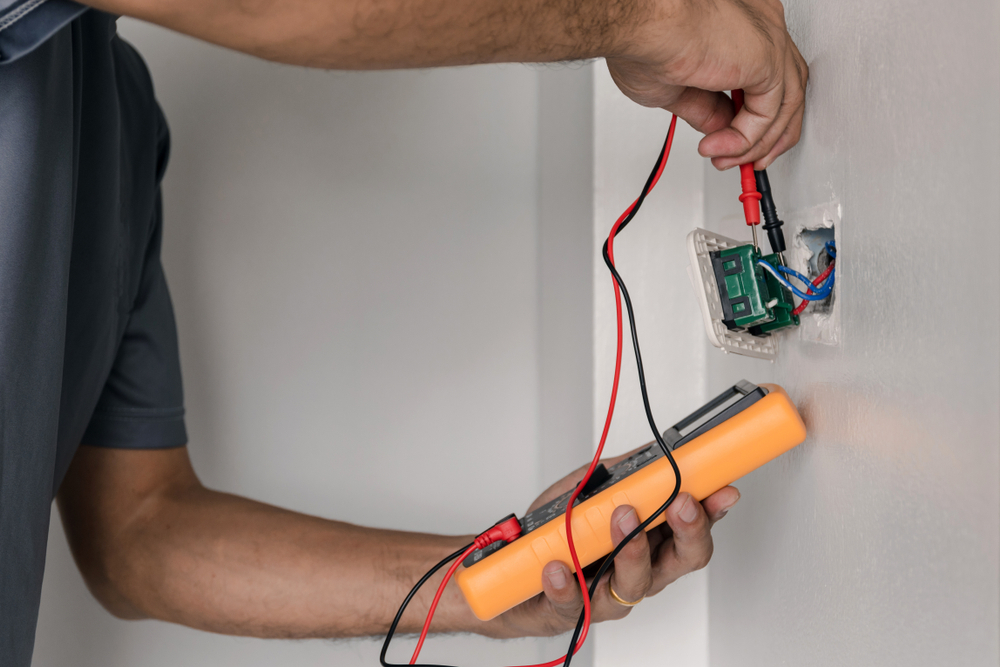
Do GFCI Outlets Go Bad?
Ground fault circuit interrupter (GFCI) outlets are the homeowner’s answer to electrical needs in locations near water. But what happens after these particular outlets are continuously exposed to water? Do they eventually lose their capability to shield us from electrical shock?
Here is everything you need to know about GFCI outlets and how we can protect them so they can keep protecting you.
What Is a GFCI Outlet?
A GFCI outlet is an outlet specifically designed to be used in places like bathrooms, kitchens, garages, outside pools, and basements. These specific outlets are required by the National Electrical Code to be placed in areas where water is present, and they’re helpful for any space that may come in contact with high amounts of moisture.
You might recognize a few in your home by a small reset button feature that you can use if the outlet is shut off. These unique outlets detect any imbalances in the electrical current and can shut off the power to the outlet to prevent electrical shock.
So if water ever accidentally makes it onto the outlet or into a device you plug in, the GFCI is smart enough to immediately turn off the outlet, stopping the ground fault—or the conducting connection—and keeping you safe from harm.
How Can You Tell a GFCI Outlet Is Going Bad?
Unfortunately, the GFCI can become undone by the very thing it is designed to protect you from—water. Consistent exposure to water and frequent shut-offs lead to corrosion and can cause parts to fail. Because of their usefulness, your GFCI outlets should be working correctly. But how can you recognize if your GFCI has started to go bad?
Testing Your GFCI
On your GFCI, you will likely see a red button and a black button. The red is the reset button mentioned above, and this is primarily used for resetting the breaker after it has been tripped. The black button, however, is used to test your outlet. Pressing this is a quick way to gauge whether your outlet has incurred any damage.
When you press it, listen for a snapping sound—that is the sound you want, as it means the circuit was successfully interrupted. You can double-check this by plugging a simple device into the outlet to see if the power is off. Leave the device plugged in, and when you hit the red reset button, the device should turn on again.
Some ground fault interrupter outlets will not come with any external testing buttons. These can be tested with their own separate plug-in circuit tester, so they are quicker to get an accurate reading.
Regardless of the type, you should be testing your GFCI outlets at least once a month. If the outlet is outside or near a swimming pool, you should be checking on them even more often, as the constant exposure to water or the elements makes them more susceptible to damage.
What Are Some of the Reasons My Outlets Stop Working?
If your GFCI outlets are constantly tripping, they have likely incurred damage and should be looked at by a team of qualified electricians. GFCI outlets that are overextended will eventually fade away and need to be replaced or repaired. But there are other ways these particular outlets can be damaged and fail before their prime.
Here are some common ways your outlets can be tripped excessively, signaling it is time for a call to your Medfield electricians.
Moisture
Water is the number one enemy of GFCI outlets, but it does not always come in the form of a splash or a rainstorm. High humidity can also lead to moisture buildup, affecting your GFCI.
The more this outlet is exposed to the humidity, the higher the chances are of it tripping and not working correctly. If you are concerned about high humidity around your outlets, be careful: faulty GFCI outlets exposed to these conditions could cause electric shock.
Overloaded Circuits
If your circuit is constantly tripping, there is a chance that you’re working it too hard. GFCI outlets are smart enough to break circuits whenever they sense an overload. So if you are using malfunctioning appliances or too much power, you could end up with a busted outlet.
Faulty Wiring
New wiring or any electrical work that is not done correctly can lead to a brand-new set of issues for your home’s outlets.
While it might not be as common, it is worth mentioning that GFCI outlets can also trip because of your home’s structural wiring. A professional electrician should look at any problems with your home’s wiring. They should be able to diagnose your issue, identify the faulty wiring, and help you find a solution.
Defective Outlet
It could be time to face facts: you are likely working with a defective outlet if you have ruled everything else out. A GFCI outlet that cannot be fixed by addressing the issues above—and does not get better with a reset—will need repairing or replacing by an electrician.
It is best to avoid using this outlet until your electrician has performed a new outlet installation.
How Often Do GFCI Outlets Need to Be Replaced?
The answer to this will depend on your GFCI’s performance. Most Medfield homeowners will find that their GFCI outlets last ten to 25 years.
If your outlets are constantly exposed to water or tripping regularly, they probably will not make it past five years. Electrical surges caused by lightning strikes can also cause your GFCI to break, bringing that number down even further.
The best way to ensure your outlets are in working order is to call professional electricians for guidance. They can fix the faulty outlet or install a new one.
Replacements for defective outlets are crucial for the safety of your home, so take your electrical inspections seriously and call in an expert for help when you need it.
GFCI Outlets and Safety
GFCI outlets are installed in homes for a good reason: to protect your family from the dangers of electricity around water. With proper testing, you can often use these outlets without fear.
And if you are building a new space, such as an outdoor pool area or expanding your basement, remember that you are required to have GFCI outlets installed in these areas.
But outlets exposed to excessive heat, moisture, or UV light can cause your ground fault interrupter to fail. That’s why it’s so important to ensure you’re testing your outlets regularly and avoiding unnecessary contact with water.
So when in doubt, do not use outlets that could be possibly faulty until you have run a test or worked with an experienced electrician.
And if you end up with a broken GFCI outlet, you should never consider replacing or installing an outlet yourself. Oftentimes, this results in an even more broken outlet.
And trying to fix an outlet can be extremely dangerous because you are working with electricity—which can be lethal if you do not know what you are doing. One wrong move could mean a potentially deadly electric shock or a devastating electrical fire.
No matter what electrical services you need in Medfield and surrounding areas, it is always best to contact your local professional electricians to help. You will be much better off.
Call Paul Macrina Electrical Contracting for GFCI Outlet Installation
When Medfield homeowners need help with outlet installation, they call the qualified electricians at Paul Macrina Electrical Contracting.
Our team of professionals can help assess any damage to your GFCI outlets and help you develop a plan to keep you and your family safe. We never let outlet troubles outsmart our experts, so call us today for assistance!
STAY IN THE LOOP
Subscribe to our free newsletter.
Related Posts
The Importance of Upgrading Your Electrical Outlets in Medfield, MA Your electrical outlets are going to need upgrading eventually. Normal wear and tear can cause the outlets to malfunction. However, even properly working outlets may need upgrading, and we are here to tell you why. Upgrading your outlets can protect your appliances and help you

